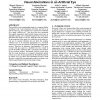Free Online Productivity Tools
i2Speak
i2Symbol
i2OCR
iTex2Img
iWeb2Print
iWeb2Shot
i2Type
iPdf2Split
iPdf2Merge
i2Bopomofo
i2Arabic
i2Style
i2Image
i2PDF
iLatex2Rtf
Sci2ools
ASSETS
2005
ACM
2005
ACM
Verification of computer display pre-compensation for visual aberrations in an artificial eye
The possibility of pre-compensating images in a computer display according to the visual aberrations previously assessed in an optical system (e.g., the computer user’s eye) has been confirmed for a simple “artificial eye”. This device has been constructed from optical components, which include a plano-convex lens, an adjustable aperture, and a Charged-Couple Device (CCD) array that mimics the retina of a real eye. While the CCD array allows for the inspection of the image as it would form on the retina of a real eye, its specular reflection does not allow the resulting “artificial eye” to be measured appropriately in a wavefront analyzer (a necessary pre-requisite for the image precompensation process). Therefore, an alternative, interchangeable CCD array covered with gray paint (i.e., disabled) was also created to provide the diffuse reflectivity that is presumed in the operation of the wavefront analyzer. Experiments with this system show that the visual aberrations in a ...
| Added | 13 Oct 2010 |
| Updated | 13 Oct 2010 |
| Type | Conference |
| Year | 2005 |
| Where | ASSETS |
| Authors | Miguel Alonso Jr., Armando Barreto, Julie A. Jacko, Malek Adjouadi |
Comments (0)

